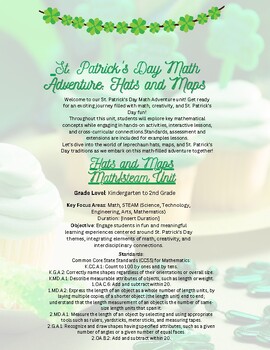ST.PATRICKS DAY CROSS-CURRICULAR UNIT
- PDF
Description
St. Patrick's Day Math Adventure: Hats and Maps
Grade Level: Kindergarten to 2nd Grade
Overview: The "St. Patrick's Day Math Adventure: Hats and Maps" unit is an interdisciplinary exploration designed to engage students in fun and meaningful learning experiences centered around St. Patrick's Day themes. This unit integrates elements of STEAM (Science, Technology, Engineering, Arts, Mathematics) through hands-on activities, interactive lessons, and cross-curricular connections.
Unit Description: The unit spans over 50 pages of comprehensive resources, including worksheets, interactive slides, and engaging activities tailored for students in grades K-2. Each lesson within the unit is carefully crafted to address key mathematical concepts while incorporating elements of creativity, critical thinking, and problem-solving.
Key Components:
Math Activities
- Coin Counting: Students will practice identifying and counting coins, with a focus on pennies, nickels, and dimes.
- Shapes and Patterns: Students will explore geometric shapes and patterns through St. Patrick's Day-themed activities.
- Addition and Subtraction: Students will reinforce addition and subtraction skills within the numbers 5-10 range.
- Measurement: Students will engage in hands-on measurement activities, comparing lengths and sizes using non-standard units.
- Number Sense: Students will develop number sense through various activities and games, reinforcing counting, sequencing, and number recognition skills.
Maps and Legends:
- Students will learn about maps and legends, exploring concepts such as directions, symbols, and keys.
- They will create their own maps of imaginary St. Patrick's Day worlds, incorporating landmarks and symbols inspired by Irish culture.
Design Your Own Leprechaun Hat:
Students will unleash their creativity by designing and measuring their own leprechaun hats.
They will use rulers and measuring tools to determine dimensions, reinforcing measurement skills in a fun and practical context.
Crafts, Puppets, and Clipart:
The unit includes a variety of craft activities, such as creating leprechaun puppets, decorating shamrock clipart, and designing St. Patrick's Day-themed artwork.
Assessment: Assessment throughout the unit will be conducted through a combination of formative and summative methods, including observation, student participation, completion of worksheets, and performance on interactive activities. Additionally, students' understanding and application of mathematical concepts will be assessed through written responses, problem-solving tasks, and hands-on projects.
Extension Activities:
- Students can create their own St. Patrick's Day-themed board games, incorporating math concepts such as counting, addition, and subtraction.
- They can conduct surveys and collect data related to St. Patrick's Day traditions, such as favorite colors, foods, or activities.
- Students can collaborate on a classroom mural or display showcasing their maps, hats, and artwork created during the unit.
The "St. Patrick's Day Math Adventure: Hats and Maps" unit provides a comprehensive and engaging approach to math instruction, fostering interdisciplinary connections and promoting creativity and exploration in the classroom. Through hands-on activities and interactive learning experiences, students will develop essential math skills while celebrating the spirit of St. Patrick's Day.





